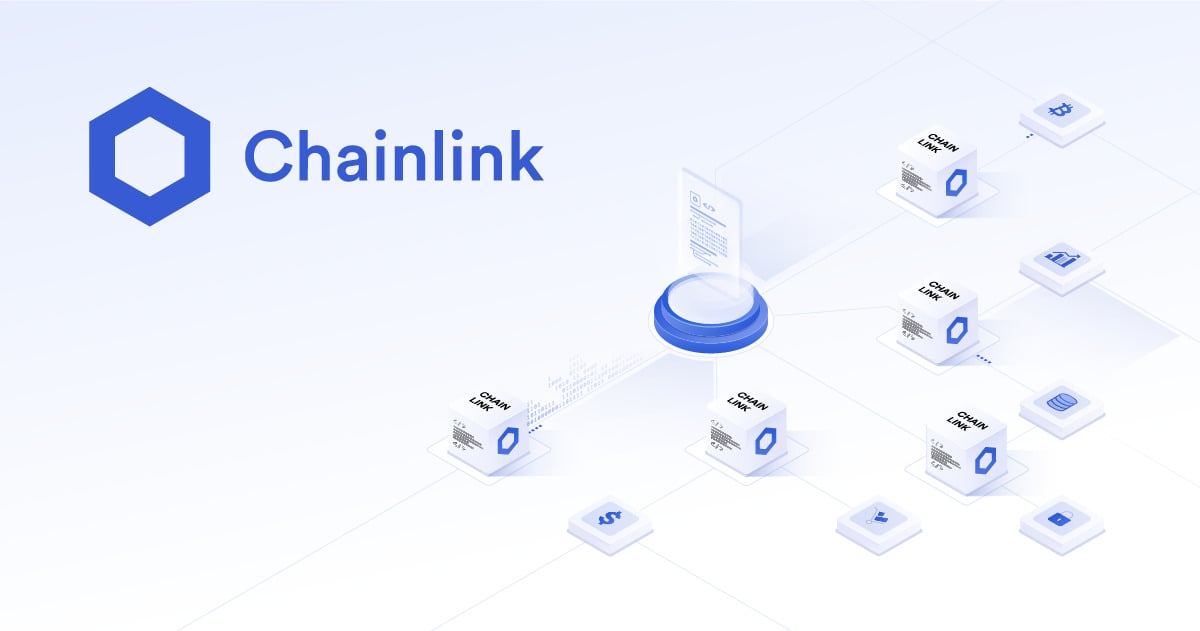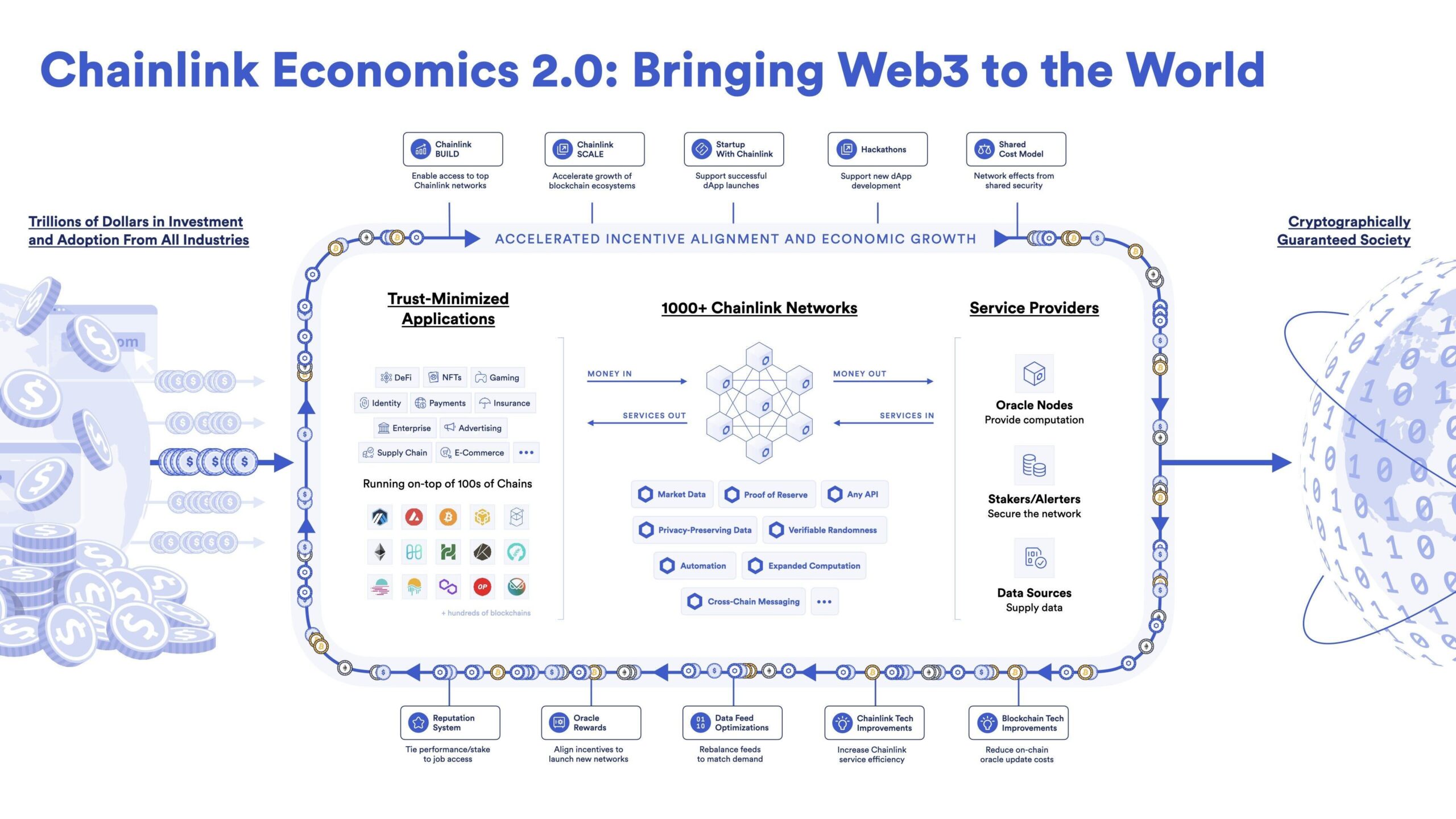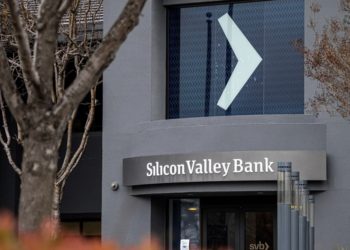Chainlink is a decentralized oracle based on Ethereum that connects non-blockchain systems to blockchain networks. The goal of Chainlink is to connect data stored on traditional mediums to the emerging blockchain ecosystem.
Chainlink là gì?


Nguồn: Chainlink
The idea behind Chainlink was born in 2017. Sergey Nazarov and Steve Ellis put the network together. However, they had some help. The original Chainlink whitepaper (v1.0) was co-authored by Ellis, Nazarov, and Cornell University Professor Ari Juels.
The whitepaper’s premise was that smart contracts would revolutionize the world, but they had one critical problem. The problem is that the consensus mechanisms of smart contracts stopped them from directly connecting with off-chain data.
Ellis, Nazarov, and Juels argued that this limited the functionalities of smart contracts. The lack of connectivity meant smart contracts could not rely on data from key resources outside the blockchain. Hence, the capacity of these contracts was hobbled by their lack of information-gathering capacity.
The solution the whitepaper suggests is the creation of an oracle. This oracle, the paper argued, would provide outside connectivity to on-chain smart contracts. This would make the smart contract even more resilient and impervious to attacks.
The whitepaper argued that Chainlink wouldn’t just be a connecting oracle — it would be a decentralized one as well. This allows the tamperproof and independent quality of smart contracts to be extended to their connection to non-blockchain environments.
The whitepaper notes that smart contracts can only reliably replace digital agreements if made “externally aware.” In essence, Chainlink would make it possible for smart contracts to respond to external events through a decentralized conduit.
Two years after Nazarov, Ellis, and Juels wrote the paper, the Chainlink network finally came online.
Thị trấn Crier và Chainlink
Before Chainlink was launched, it needed to solve its hardware problem. If Chainlink was ever going to be a successful network, it needed to work with reliable hardware. To solve that problem, Nazarov and Ellis partnered with Town Crier, an execution environment-based blockchain tool. Town Crier runs inside a cold piece of hardware called a secure enclave. This enclave hardware protects the oracle from external threats and keeps it safe.
This enclave also receives queries for data from the smart contract and then searches for that data online. On the other hand, Chainlink puts together a decentralized network of data sources that makes the oracle more resilient. This ensures that the oracle draws on multiple data sources and isn’t reliant on only one.
Through the partnership of Town Crier and Chainlink, smart contracts can always be executed with the highest quality information from diversified and decentralized sources. This reduces occurrences of error and allows smart contracts to truly revolutionize digital contracts.
Trước Chainlink
The proposal in Chainlink’s whitepaper isn’t the first of its kind. Certain smart contracts cannot work without oracles. Oracles, in this case, are real-time data feeds that provide data from the internet to the blockchain.
However, before Chainlink, these data feeds were centralized pipelines. This means that they could be hacked by bad actors and are generally susceptible to the dangers of centralized systems. Additionally, using smart contracts and then relying on centralized oracles make smart contracts no more secure than traditional digital contracts.
Chainlink’s important contribution to crypto is to decentralize this information pipeline. This removes any chance of error or external hack and makes smart contracts safer and more efficient for everyone.
Trường hợp sử dụng Chainlink
One big problem for crypto projects is the lack of use cases. Chainlink is unique because it has ready-made use cases.
1. Stablecoins
One exciting use case for Chainlink is keeping stablecoins stable. For algorithmic stablecoins to maintain their value, they need a secure connection to track the value of their underlying asset. Chainlink could perform this function quite well.
2. Decentralized Finance
Another use case for Chainlink is as a conduit for tracking contracts in decentralized finance. Decentralized Finance is a vast market that relies heavily on many off-chain data to work properly. This off-chain data is needed to moderate collateral levels, close out positions, determine exchange rates, and other actions.
If these contracts rely on centralized oracles, they remain susceptible to the dangers of centralized systems. Chainlink solves this problem quite easily and improves the safety and efficiency of the smart contract.
3. Yield Farming
Yield farming, which is the process of earning interest in crypto, is one of the most lucrative fields in Web3. The smart contracts that power yield farming cannot work without connecting to off-chain sources. If the liquidity pools don’t get data about how tokens are doing in the broader crypto market, smart contracts will not realize when certain conditions have been met.
In the past, criminals have used the oracles that feed this data to the pools to attack it. If these characters can manipulate the data fed to the smart contracts, they can change how the smart contract is executed.
Today, several DeFi protocols use DeFi specifically to provide tamper-proof price feeds.
Chainlink và Ethereum
The Chainlink protocol is built on the Ethereum network. Chainlink can help Ethereum projects establish a secure and resilient link to off-chain data. The LINK token, which is Chainlink’s native coin, can only pay node operators in the Chainlink network.
Tăng trưởng của Chainlink
2021
Chainlink has grown tremendously ever since it came online in 2019. The company reached astronomical heights in 2021 during the 2021 crypto bull market.
In 2021, the network surpassed a $75 billion total secured value figure. Total secured value figures calculate how many network oracles have been secured or saved from theft.
That same year, Chainlink expanded the scope of the data it was supplying. The network added Proof-of-Supply, Proof-of-Reserve, Ethereum gas data, election race calls, compliance metrics, total market cap, and sports game results. As a result, the network expanded the types of projects it could be integrated with.
In 2021, the Chainlink ecosystem grew to include over a thousand projects. More than half of those integrations happened in 2021. This exponential increase meant Chainlink-integrated projects now covered a significant portion of the total value locked in DeFi projects.
Chainlink has also serviced over 2.5 million requests for secure off-chain computation.
2022
2022 was an extraordinary year for Chainlink as well. The company surpassed $6.9 billion in Transaction Value Enabled (TVE) and added more than 600 projects to its 1000 project figure from 2021.
Asides from important strides in market expansion, Chainlink also took enviable strides in talent acquisition. The former project lead for Google’s Tensorflow, former Diem CTO, and Diem co-founder joined the Chainlink team.
And finally, Sergey Nazarov announced at a conference in 2022 that Chainlink now ran over 60% of all oracle computations for decentralized apps.
Chainlink VRF
As Chainlink grew, so did its opportunities to provide even more services to the decentralized economy.
Chainlink realized that decentralized projects didn’t have a reliable source of randomness. On-chain randomness is subject to block withholding attacks, while off-chain randomness requires a high level of trust.
Chainlink created the Verifiable Randomness Function (VRF) to solve this problem. VRF was created to provide smart contract developers with true randomness. With each query, Chainlink creates a random number and provides cryptographic proof of how it was generated. This ensures that true randomness is created and outcomes are truly a product of blind luck.
Chainlink Economics 2.0


Source: Chainlink’s Twitter
Since 2019 until now, Chainlink has had an enviable performance in the market. The company has expanded its market share exponentially and is now the industry standard for oracle services.
Despite this level of success, Chainlink still believes it can grow further and faster. That’s why the company recently announced Chainlink Economics 2.0.
Nazarov says Chainlink 2.0 will allow members of the Chainlink community to commit LINK tokens to smart contracts. These stakes would back certain performance metrics of the network’s oracle services.
According to Chainlink’s staking roadmap, the long-term goal of Chainlink staking is to create a multi-chain smart contract economy. This smart contract economy would support “multi-trillion-dollar markets across major global industries.”
On the Flipside
- Chainlink may be decentralized, but the network still depends on Ethereum. Any problem with the Ethereum network will immediately spill over to Chainlink.
Why You Should Care
Chainlink is the leading oracle provider in the decentralized ecosystem. It’s a big player in Web3, and it’s important to understand how it works, why it works, and what its future may look like.



























